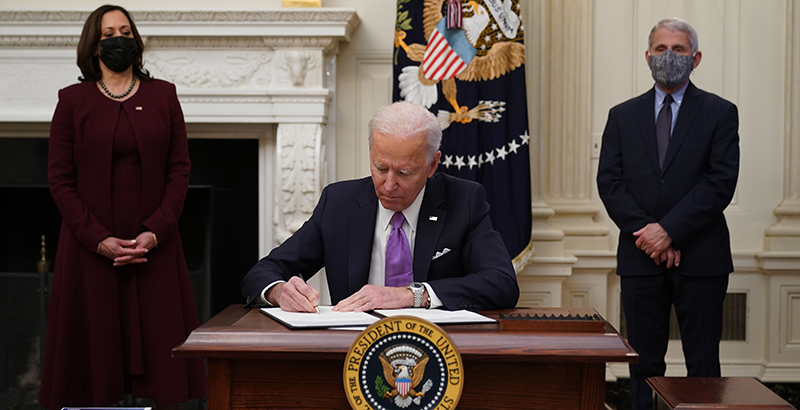With an Eye Toward Equity, Biden Unveils Plan to Reopen Many Schools in First 100 Days

Moving toward his goal of reopening most K-8 schools in 100 days, President Joe Biden spent his second day in office signing executive orders that direct multiple federal agencies to work together to get schools to resume in-person learning.
During a press conference, Dr. Anthony Fauci also said the nation could be close to a return to normal by the 2021-22 school year, but that’s only if at least 70 percent of the population is vaccinated. “The concern I have, and something we’re working on, is getting [to] people who have vaccine hesitancy,” he said.
As part of Biden’s national strategy, he directed the Department of Education and the Department of Health and Human Services to establish a hub for information on school reopenings and closures.
The information, according to the administration, will help schools understand how closures have affected students of color, low-income families, English learners, students with special needs and others who have experienced the worst effects of being away from the classroom. For those who have been doing such work since last March, the announcements were welcome news.
“We need a national effort, one that builds consistency in the data collected and the viable conclusions that can be drawn from it,” said Annette Campbell Anderson, an assistant professor at Johns Hopkins University who has been tracking state policies on school reopening. “Up until now, it has been a hodgepodge of responses of data collected, and most parents, especially those in urban centers, won’t feel confident in returning their children to in-person schools until there is some reliable longitudinal data to consider.”
With the 100-day clock now ticking, educators are hopeful about the organized federal response to the pandemic. The National Education Association called the executive order “an important first step to ensure the protections and significant resources are in place to support the safe and just return to in-person instruction in school buildings and on campuses.” The orders signed Thursday also cover issues such as reimbursements for masks and other supplies and creating a handbook to help guide reopening strategies — tasks many states and districts have been managing themselves. Experts, however, see room to build on what they’ve done before.
The school reopening order directs the education department to create a “best practices clearinghouse” so schools can share what they’ve learned in their efforts to safely reopen.
It requires the future assistant secretary for civil rights to produce a report “as soon as practicable” on the unequal impact of the pandemic on students.
And it directs the Federal Communications Commission to “increase connectivity options for students lacking reliable home broadband.” To support that goal, Biden on Thursday named FCC Commissioner Jessica Rosenworcel acting chair of the FCC. The ranking Democrat on the commission, Rosenworcel has been an outspoken advocate for extending an internet discount program for schools to cover at-home service for students.
Another order on governors’ use of the National Guard directs the Federal Emergency Management Agency to fully reimburse schools for what they spend on masks and other protective equipment. FEMA will work with the education department and the Centers for Disease Control and Prevention to give schools access to funds for sanitation products and improving ventilation systems.
In September, district leaders got conflicting messages when FEMA said it would stop reimbursing schools and other nonemergency sites for cloth face masks while on the same day, the Department of Health and Human Services said it was disbursing millions of masks to schools.
Multiple education groups expressed support for Biden’s actions. AASA, the School Superintendents Association, said the plan responds to concerns district leaders expressed to Biden’s transition team, but also leaves them in charge of decisions at the local level.
While districts such as Los Angeles Unified have asked for schools to serve as vaccination centers, the Biden plan doesn’t call for schools to be included on its list along with stadiums, conference centers and retail stores.
Some experts provided additional feedback on how the federal government can be helpful, particularly around data collection.
Robin Lake, director of the Center on Reinventing Public Education at the University of Washington, said it would be useful for states to report whether their schools are open or closed. The center’s tracker on district closures and reopenings has been a widely-used source for experts looking for patterns as well as successful models.
She said it would also be helpful to know the number of COVID-19 cases among adults and students, the health and safety measures districts are implementing and the assessments and strategies districts are using to help students recover from learning loss.
“The administration should not start from scratch. We and others have a start on this,” Lake said. “It will be important to build on that. We can’t waste time.”
Get stories like these delivered straight to your inbox. Sign up for The 74 Newsletter

;)
